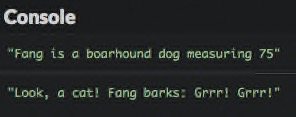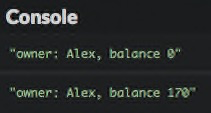Create your first objects
This chapter will introduce objects and the way they are created and used in JavaScript.
Introduction
What's an object?
Think about objects in the non-programming sense, like a pen. A pen can have different ink colors, be manufactured by different people, have a different tip, and many other properties.
Similarly, an object in programming is an entity that has properties. Each property defines a characteristic of the object. A property can be a piece of information associated with the object (the color of the pen) or an action (the pen's ability to write).
What does this have to do with code?
Object-oriented programming (OOP for short) is a way to write programs using objects. When using OOP, you write, create, and modify objects, and the objects make up your program.
OOP changes the way a program is written and organized. So far, you've been writing function-based code, sometimes called procedural programming. Now let's discover how to write object-oriented code.
JavaScript and objects
Like many other languages, JavaScript supports programming with objects. It provides a number of predefined objects while also letting you create your own.
Creating an object
Here is the JavaScript representation of a blue Bic ballpoint pen.
As stated earlier, a JavaScript object can be created by simply setting its properties within a pair of curly braces: {...}. Each property is a key/value pair. This is called an object literal.
Warning
The semicolon ; after the closing brace is optional, but it's safer to add it anyway.
The above code defines a variable named pen whose value is an object: you can therefore say pen is an object. This object has three properties: type, color and brand. Each property has a name and a value and is followed by a comma , (except the last one).
Accessing an object's properties
After creating an object, you can access the value of its properties using dot notation such as myObject.myProperty.
const pen = {
type: "ballpoint",
color: "blue",
brand: "Bic"
};
console.log(pen.type); // "ballpoint"
console.log(pen.color); // "blue"
console.log(pen.brand); // "Bic"
Accessing an object's property is an expression that produces a value. Such an expression can be included in more complex ones. For example, here's how to show our pen properties in one statement.
const pen = {
type: "ballpoint",
color: "blue",
brand: "Bic"
};
console.log(`I write with a ${pen.color} ${pen.brand} ${pen.type} pen`);

Modifying an object
Once an object is created, you can change the value of its properties with the syntax myObject.myProperty = newValue.
const pen = {
type: "ballpoint",
color: "blue",
brand: "Bic"
};
pen.color = "red"; // Modify the pen color property
console.log(`I write with a ${pen.color} ${pen.brand} ${pen.type} pen`);

JavaScript even offers the ability to dynamically add new properties to an already created object.
const pen = {
type: "ballpoint",
color: "blue",
brand: "Bic"
};
pen.price = "2.5"; // Set the pen price property
console.log(`My pen costs ${pen.price}`);

Programming with objects
Many books and courses teach object-oriented programming through examples involving animals, cars or bank accounts. Let's try something cooler and create a mini-role playing game (RPG) using objects.
In a role-playing game, each character is defined by many attributes like strength, stamina or intelligence. Here's the character screen of a very popular online RPG.

In our simpler example, a character will have three attributes:
- her name,
- her health (number of life points),
- her strength.
A naive example
Let me introduce you to Aurora, our first RPG character.
The aurora object has three properties: name, health and strength.
Note
As you can see, you can assign numbers, strings, and even other objects to properties!
Aurora is about to start a series of great adventures, some of which will update her attributes. Check out the following example.
const aurora = {
name: "Aurora",
health: 150,
strength: 25
};
console.log(`${aurora.name} has ${aurora.health} health points and ${aurora.strength} as strength`);
// Aurora is harmed by an arrow
aurora.health -= 20;
// Aurora equips a strength necklace
aurora.strength += 10;
console.log(`${aurora.name} has ${aurora.health} health points and ${aurora.strength} as strength`);

Introducing methods
In the above code, we had to write lengthy console.log statements each time to show our character state. There's a cleaner way to accomplish this.
Adding a method to an object
Observe the following example.
const aurora = {
name: "Aurora",
health: 150,
strength: 25
};
// Return the character description
function describe(character) {
return `${character.name} has ${character.health} health points and ${character.strength} as strength`;
}
console.log(describe(aurora));

The describe() function takes an object as a parameter. It accesses that object's properties to create a description string.
Below is an alternative approach, using a describe() property inside the object.
const aurora = {
name: "Aurora",
health: 150,
strength: 25,
// Return the character description
describe() {
return `${this.name} has ${this.health} health points and ${this
.strength} as strength`;
}
};
console.log(aurora.describe());

Now our object has a new property available to it: describe(). The value of this property is a function that returns a textual description of the object. The execution result is exactly the same as before.
An object property whose value is a function is called a method. Methods are used to define actions for an object. A method adds some behavior to an object.
Calling a method on an object
Let's look at the last line of our previous example.
To show the character description, we use the aurora.describe() expression instead of describe(aurora). It makes a crucial difference:
-
describe(aurora)calls thedescribe()function with theauroraobject as an argument. The function is external to the object. This is an example of procedural programming. -
aurora.describe()calls thedescribe()function on theauroraobject. The function is one of the object's properties: it is a method. This is an example of object-oriented programming.
To call a method named myMethod() on an object myObject, the syntax is myObject.myMethod().
Warning
Remember to add parentheses, even if empty, when calling an object's method!
The this keyword
Now look closely at the body of the describe() method on our object.
const aurora = {
name: "Aurora",
health: 150,
strength: 25,
// Return the character description
describe() {
return `${this.name} has ${this.health} health points and ${this
.strength} as strength`;
}
};
You see a new keyword: this. This is automatically set by JavaScript inside a method and represents the object on which the method was called.
The describe() method doesn’t take any parameters. It uses this to access the properties of the object on which it is called.
JavaScript predefined objects
The JavaScript language has many predefined objects serving various purposes. We have already encountered some of them:
-
The
consoleobject gives access to the environment console.console.log()is actually a method call. -
The
Mathobject contains many mathematical properties. For example,Math.PIreturns an approximate value of the number π (Pi) and theMath.random()function returns a random number between 0 and 1.
TL;DR
-
A JavaScript object is an entity that has properties. Each property is a key/value pair. The key is the property name.
-
The value of a property can be a piece of information (number, string, etc) or a function. In the latter case, the property is called a method.
-
A JavaScript object literal is created by simply setting its properties within a pair of curly braces.
const myObject = {
property1: value1,
property2: value2,
// ... ,
method1(/* ... */) {
// ...
},
method2(/* ... */) {
// ...
}
// ...
};
myObject.property1 = newValue; // Set the new value of property1 for myObject
console.log(myObject.property1); // Show the value of property1 for myObject
myObject.method1(...); // Call method1 on myObject
-
Inside a method, the
thiskeyword represents the object on which the method is called. -
The JavaScript language predefines many useful objects like
consoleorMath.
Coding time!
Adding character experience
Improve our example RPG program to add an experience property named xp to the character. Its initial value is 0. Experience must appear in character description.
// TODO: create the character object here
// Aurora is harmed by an arrow
aurora.health -= 20;
// Aurora equips a strength necklace
aurora.strength += 10;
// Aurora learn a new skill
aurora.xp += 15;
console.log(aurora.describe());

Modeling a dog
Complete the following program to add the dog object definition.
// TODO: create the dog object here
console.log(`${dog.name} is a ${dog.species} dog measuring ${dog.size}`);
console.log(`Look, a cat! ${dog.name} barks: ${dog.bark()}`);

Modeling a circle
Complete the following program to add the circle object definition. Its radius value is input by the user.
const r = Number(prompt("Enter the circle radius:"));
// TODO: create the circle object here
console.log(`Its circumference is ${circle.circumference()}`);
console.log(`Its area is ${circle.area()}`);
Modeling a bank account
Write a program that creates an account object with the following characteristics:
- A
nameproperty set to "Alex". - A
balanceproperty set to 0. - A
creditmethod adding the (positive or negative) value passed as an argument to the account balance. - A
describemethod returning the account description.
Use this object to show its description, crediting 250, debiting 80, then show its description again.
